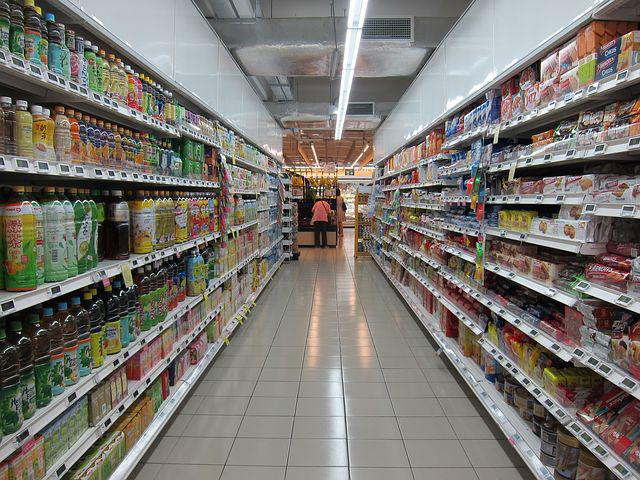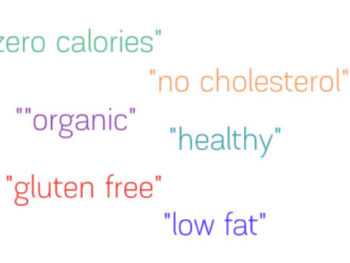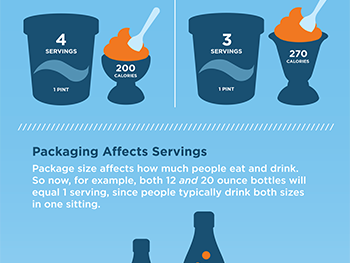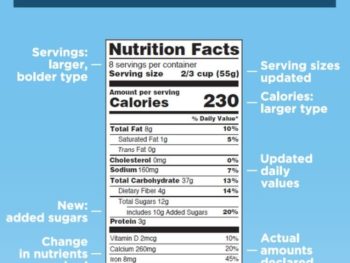Have you ever purchased one food item over another because the nutrient claim on the package gave you the impression that it was the healthier choice? You may have been misled.
Many terms on food labels can confuse even the most educated consumers into thinking that a packaged food product is healthy when in fact, it is anything but healthy.
Here are several—often misleading—terms that manufacturers often use on packaged food labels along with my tips on how not to be fooled. Such terms are often “health halos,” giving consumers the impression that the product is healthy thereby encouraging you to eat more than they may ordinarily consume.
1. Multigrain
When shopping for healthy grains, including bread, pasta, and crackers, looks—and words—can be deceiving. A loaf of bread, for example can be flavored with molasses or caramel coloring and have that brown “healthy” look but may not be any healthier than refined white bread. The term multigrain, for example, means that the product must contain two or more grains. But those grains may or may not be healthy whole grains.
Whole grains, including whole wheat breads and pasta, oatmeal, quinoa, and brown rice contain more nutrients and fiber than refined products which have been stripped away of the bran and germ, the grain’s healthy components. Recommendations advise that at least half of our grains be whole grains so read labels carefully.
My tip: When reading food labels, if you want to be assured that your product is healthy, look for the words 100% whole grain or 100% whole wheat as opposed to multigrain. And be sure to read the ingredient list which tells a lot. Ingredients are listed in descending order of predominance by weight, meaning that the ingredient that weighs the most is listed first. The ingredient list tells you like it is.
2. Zero trans fat
Trans fat is just about the most unhealthy fat you can have. It is bad for your heart, is generally found in heavily processed foods, and the ideal amount to have is none at all. However, products are allowed to say that they contain “zero trans fats” if one serving contains less than 0.5 grams. This is deceiving because if you eat multiple servings—which so many of us do—the grams of trans fats add up quite easily.
My tip: Read the ingredient list and if “partially hydrogenated vegetable oil,” is listed, then the product contains trans fats, and I suggest you keep it on the shelf instead of adding it to your grocery cart.
3. Fat–free
The term fat-free can be notoriously misleading. Many products that bear this label are not as healthy as you might think and just because a label says fat-free, it doesn’t mean that the food product is calorie-free and that you can eat as much as you want. Fat-free products often tend to be loaded with sugar and are not healthy at all, despite what many consumers often think.
I’ve had many clients over the years that think they don’t have to pay attention to their portion size of fat free products. However, many fat-free cookies have just as many calories as their full-fat version. And many fat-free versions taste awful and just leave us wanting more.
My tip: Check the label for calorie content, and compare it to the full-fat version. And watch out for the added sugar.
4. Sugar–free
According to FDA, the nutrient claim sugar-free means that a product contains less than 0.5 grams of sugars per serving. These products, however, may still contain calories and carbohydrates from other sources. As many consumers often think, the term sugar-free doesn’t mean the product contains fewer calories than the regular version. Oftentimes, it contains more.
Sugar-free products often contain sugar alcohols such as xylitol, maltitol, or sorbitol which do contain calories (although fewer calories than table sugar) and may also cause stomach discomfort and diarrhea. Therefore, it is very important to practice portion control.
My tip: Compare the labels of the regular and sugar-free version and be sure to check the number of calories as well. And do not eat too much of either version. In fact, the sugar-free version will probably give you a stomach ache if you eat too much.
5. Gluten free
Gluten is a protein found in grains such as wheat, barley, and rye and should not be consumed by people with celiac disease or a gluten intolerance. These days, gluten-free products are very easy to find with the proliferation of new products regularly hitting store shelves.
Gluten-free products, however, are not necessarily any healthier than those with gluten and can often actually be less healthy and contain more sugar and salt, and less fiber.
While gluten-free products are important for those who cannot digest gluten, there is really no advantage for everyone else to buy them. And they certainly will not help you lose weight, unless of course, they are lower in calories than the regular version which is not necessarily the case.
My tip: Read food labels and compare the calories, fiber, sugar, salt, and ingredient list of the gluten-free and regular varieties. And remember gluten-free cookies are still cookies!
One final thought: Before turning to packaged foods, I’d suggest you aim to eat more whole foods—including fruits, vegetables, beans and legumes, fresh seafood, and quinoa or brown rice—without fancy packaging and lots of added ingredients.
Have a healthy week!
Warmly,
Lisa
Dr. Lisa R. Young
Are you enjoying my newsletter? Please consider forwarding it to a friend or two.
Would you like help cultivating healthier habits? managing your portions? eating and living more mindfully? incorporating more healthy plant-based meals? … and tips for eating a little better this year? I’m happy to assist. I am currently offering VIRTUAL NUTRITION COACHING & COUNSELING. I can reached HERE to discuss your unique needs to set up a free 15-minute discovery call.⠀
PS: Want a gift for the new year keeping self care, health, fitness and happy vibes in mind? Enjoy some of my favorite AMAZON PICKS in health & wellness. And… add some of these on your wish list this year.





 Foods that may boost your mood
Foods that may boost your mood